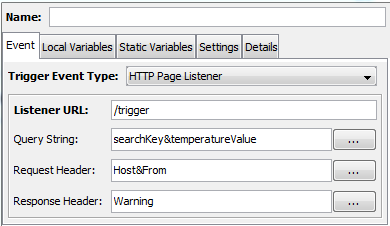A HTTP Page Listener event trigger executes when a request is received for the specified URL.
It is important to note that you cannot have more than one HTTP page listener event type trigger listening on the same page (using a given Listener URL), nor can you listen to a page that is served up by existing web applications on the gateway (such as the web management interface).
To cause a trigger that uses this event to fire, you can do the following:
- Enable the HTTP Server from the Administration > HTTP Server tab in the Workbench.
- Make an HTTP request to the URL specified in Listener URL parameter in the trigger.
Defining a HTTP page listener event trigger
To define a HTTP page listener event trigger, follow these steps:
- From the Workbench left pane, expand the node where
you want to define the HTTP page listener event
trigger.
- Select the Project icon to display
the Projects window, right-click a
specific project tab to display its pop-up menu, and
then select New.
You also can select the New button at the bottom of the Projects window when a specific project tab has already been selected. - The new Trigger window
appears.
Name the trigger. The trigger name can be up to 64 characters and include letters, numbers, and the underscore character. Spaces are allowed. - From the Event tab, select the
Trigger Event Type down-arrow, expand
the Networking category, and then
select HTTP Page Listener.

The Event tab becomes active with parameters that accommodate the HTTP page listener event.
| Parameter | Description |
|---|---|
| Listener URL | The URL that the calling application
will request. The default is /trigger, which means that if you request http://<ip address of your gateway>/trigger the trigger will be executed. Note that you cannot have more than one HTTP page listener event type trigger listening on the same page. |
| Query String | The query string fields of the URL that
the calling application will request. The
URL can contain a query string, such as
"http://host/trigger/searchKey=1334&temperatureValue=72.3". The example screenshot above shows how to map the individual query string variables into trigger input event variables. Clicking the "..." button will bring up a list editor to edit this parameter. The "&" character is reserved and is used as the string delimiter for this parameter. |
| Request Header | The HTTP header fields of the URL
that the calling application will request.
The HTTP request can contain key value
pairs in the HTTP header, such as "Host"
and "From". The example screenshot above shows how to map the individual request header key variables into trigger input event variables. Clicking the "..." button will bring up a list editor to edit this parameter. The "&" character is reserved and is used as the string delimiter for this parameter. |
| Response Header | The HTTP header fields of the
response that the trigger can supply with
the response as key value pairs. The HTTP
response can contain key pair values in the
response header. The example screenshot above shows how the trigger will inject a "Warning" field into the response header. Clicking the "..." button will bring up a list editor to edit this parameter. The "&" character is reserved and is used as the string delimiter for this parameter. |
HTTP page listener event type trigger event variables
The input event variables available to a HTTP page listener event trigger are:
| Event variable | Data type | Description |
|---|---|---|
| HTTP Content | STRING | If the incoming HTTP request is a POST, then this variable will hold the content that was POST'ed to the URL. |
| HTTP Content Length | INT4 | If the incoming HTTP request is a POST, then this variable will hold the length of the content that was submitted. |
| HTTP Content-Type | STRING | If the incoming HTTP request is a POST, then this field will contain the MIME type of the data that was submitted. |
| HTTP Method | STRING | The value of this variable will be the HTTP method that was invoked, such as: "GET", "POST", "HEAD", etc. |
| HTTP URL | STRING | The value of this variable will be the original URL that was captured by the HTTP Server. |
| HTTP Query String Variable(s) | STRING | Each query string field specified in the Query String parameter will map to a trigger input event variable. The trigger input event variable will contain a STRING value if the request contains the query string field name. |
| HTTP Request Header
Variable(s) |
STRING | Each HTTP request header field specified in the Request Header parameter will map to a trigger input event variable. The trigger input event variable will contain a STRING value if the request contains the request header field name. |
The output event variables available to a HTTP page listener event trigger are:
| Event variable | Data type | Description |
|---|---|---|
| HTTP Content | STRING | Whatever you set in this variable will be sent in the HTTP response body. The Content-Length is automatically set based on the length of the buffer that you write. |
| HTTP Content-Type | STRING | This variable should be set with the appropriate MIME type for the response data. |
| HTTP Status Code | INT4 | This variable should be set with the HTTP response code, such as: 200, 500, etc. |
| HTTP Response Variable(s) | STRING | Each HTTP response header field specified in the Response Header parameter will map to a trigger output event variable. The value will be inserted into the response header if the trigger output event variable is set. |